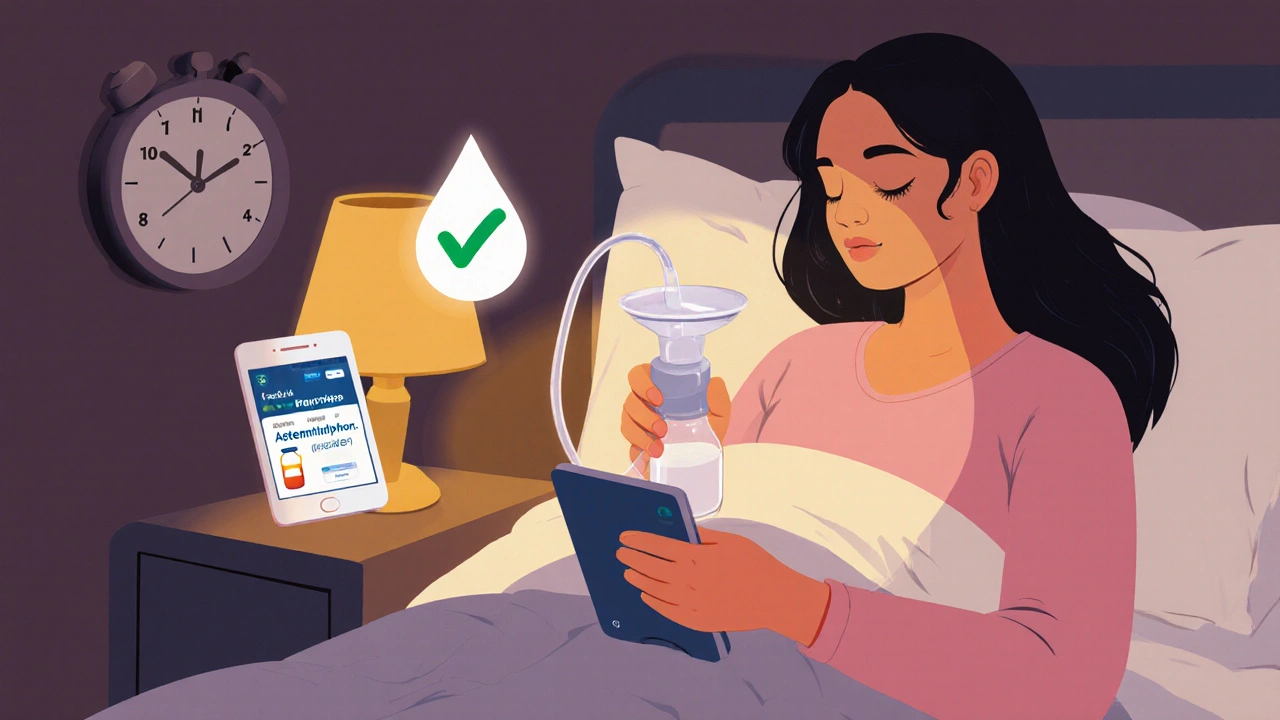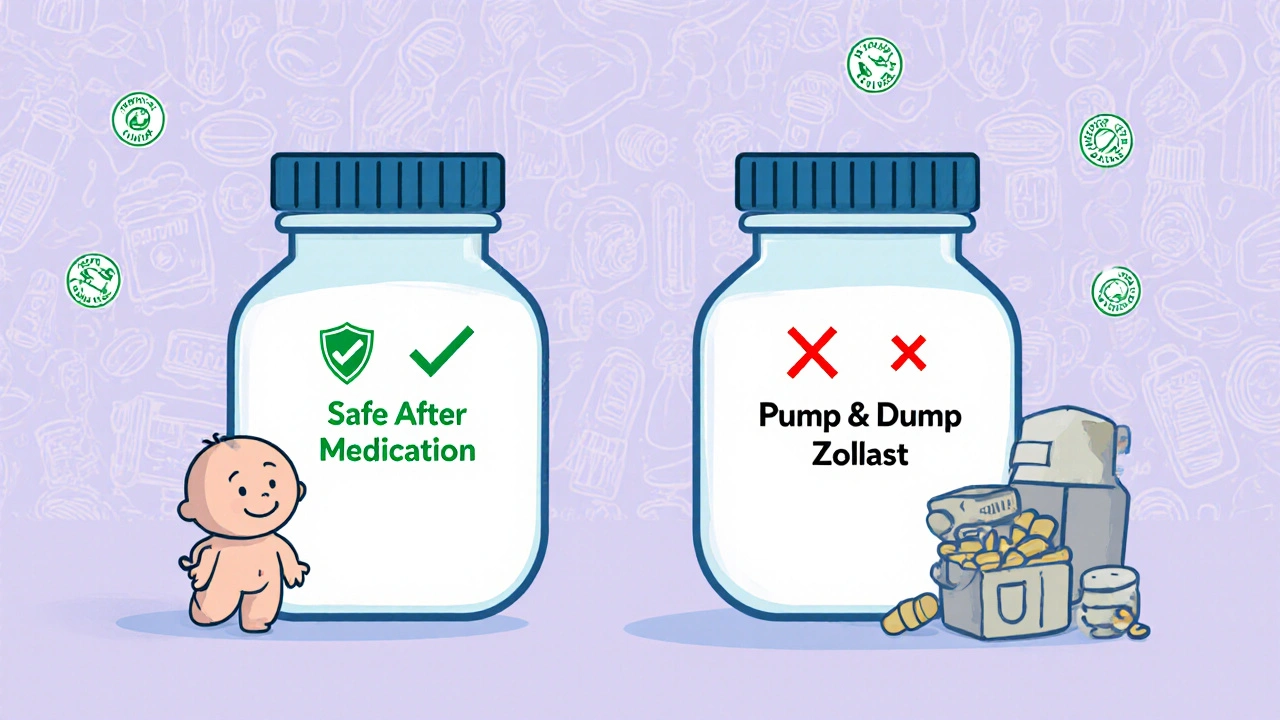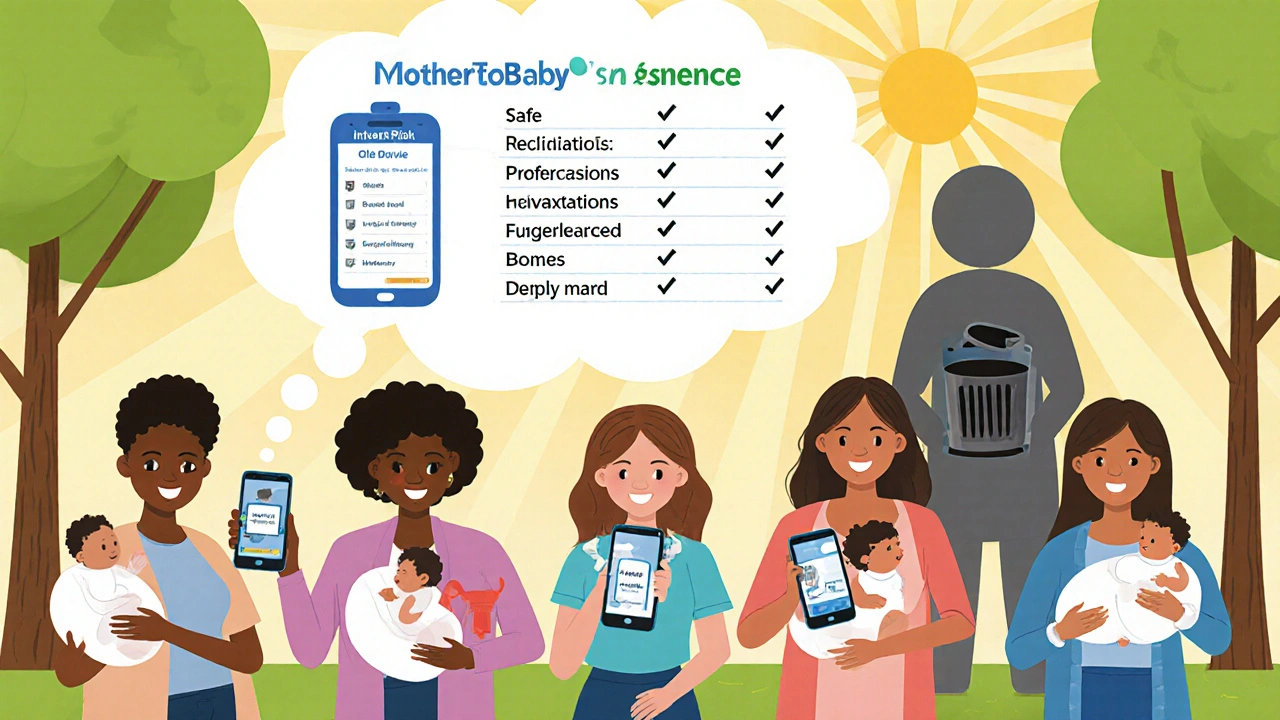Pumping and Storing Breast Milk While Taking Medication: Safe Practices You Can Trust
 Nov, 17 2025
Nov, 17 2025
When you're breastfeeding and need to take medication, the last thing you want is to stop feeding your baby. But you’ve probably heard the advice: pump and dump. It’s everywhere - from well-meaning relatives to outdated online forums. The truth? Most of the time, you don’t need to do it at all.
Why Pump and Dump Is Usually Unnecessary
For decades, doctors and pharmacists told nursing mothers to throw away their milk whenever they took any drug. The reasoning? Better safe than sorry. But today, we know better. According to the American Academy of Pediatrics, fewer than 1% of medications require you to stop breastfeeding. Most drugs pass into breast milk in tiny, harmless amounts. Dr. Thomas Hale, a leading expert in lactation pharmacology, found that 98% of medications have no documented risk to babies when taken by nursing mothers. The idea that all medications are dangerous during breastfeeding comes from old drug labels. Pharmaceutical companies often write broad warnings to avoid liability, not because the science supports it. The CDC and the American College of Obstetricians and Gynecologists now agree: unless a drug is clearly listed as unsafe, you can keep breastfeeding.How Medications Actually Enter Breast Milk
Not all drugs behave the same way. What matters is how your body handles them. Here’s what makes a medication safer for breastfeeding:- Molecular weight over 500 Daltons - Larger molecules don’t easily pass into milk.
- High protein binding (over 80%) - If the drug sticks to proteins in your blood, less is free to enter milk.
- Short half-life (under 4 hours) - The drug leaves your system quickly, so there’s less time for it to build up.
- Low lipid solubility - Fats don’t absorb it well, so it stays out of milk.
- Poor oral absorption in babies - Even if a little gets in the milk, your baby’s gut may not absorb it.
When You Actually Need to Pause Breastfeeding
There are exceptions. Only a handful of drugs truly require you to stop breastfeeding temporarily:- Radioactive isotopes - Used in some imaging tests. You’ll be given clear instructions on how long to wait.
- Certain chemotherapy drugs - These are toxic and can damage a baby’s developing cells.
- Ergot alkaloids - Used for migraines; can cause serious side effects in infants.
Timing Matters More Than Dumping
Instead of throwing away milk, use timing to reduce your baby’s exposure. It’s simple:- If you take a single daily dose, take it right after your baby’s longest sleep stretch - usually after bedtime. That gives you 6-8 hours for the drug to clear before the next feeding.
- If you take multiple doses a day, breastfeed right before you take your pill. That way, your milk is at its lowest drug concentration when your baby feeds.

Medication Comparisons: What’s Safe and What’s Not
Here’s a quick guide to common meds and their safety during breastfeeding:| Medication | Relative Infant Dose | Infant Risk | Recommendation |
|---|---|---|---|
| Acetaminophen (Tylenol) | <0.1% | Very low | Safe - no timing needed |
| Ibuprofen (Advil) | 0.01-0.06 mg/L | Very low | Safe - preferred over naproxen |
| Naproxen (Aleve) | Higher transfer, 14-hour half-life | Moderate | Use only short-term; avoid in newborns |
| Sertraline (Zoloft) | 0.5-2.5% | Very low | Safest antidepressant for breastfeeding |
| Paroxetine (Paxil) | 1.5-4.3% | Moderate | Higher transfer - use with caution |
| Cephalexin (Keflex) | 0.5-1.5% | Very low | Safe - one of the best antibiotics |
| Clindamycin (Cleocin) | 5-15% | Moderate | Can cause diarrhea in infants - monitor closely |
How to Store Breast Milk When Taking Medication
Good news: taking medication doesn’t change how you store milk. The same rules apply:- Room temperature (up to 25°C): Up to 4 hours
- Refrigerator (4°C or colder): Up to 4 days
- Freezer (-18°C): Up to 6 months
What to Do If You’re Told to Pump and Dump
Many healthcare providers still give outdated advice. A 2021 study found that 68% of mothers were wrongly told to discard milk. One mom in Chicago pumped and dumped for 72 hours after being told to avoid an antibiotic. Her milk supply dropped 40% - and never fully recovered. If your doctor says to dump, ask:- “Is this based on current guidelines or just a general warning?”
- “Can you check LactMed or MotherToBaby?”
- “Is there a safer alternative?”

Real Stories, Real Results
One mom in New Zealand took sertraline for postpartum depression. Her pediatrician said to stop breastfeeding. She called MotherToBaby instead. They told her sertraline was one of the safest options. She kept nursing. Her baby gained weight normally. No side effects. Another mom was told to dump milk for three days while on amoxicillin. She didn’t. She timed her doses after night feeds. Her baby was fine. Her supply stayed strong. On Reddit’s breastfeeding community, 63% of mothers reported being told to pump and dump unnecessarily. Those who followed evidence-based advice were far more likely to keep breastfeeding past six months.Tools to Help You Make the Right Choice
You don’t have to guess. Use these trusted resources:- LactMed - Free database from NIH with detailed info on over 1,300 drugs. Updated weekly.
- InfantRisk Center App - Free app with instant safety ratings. Downloaded over 250,000 times.
- MotherToBaby - Call or chat with experts. They speak multiple languages.
- AAFP Clinical Summary - Quick-reference guide for doctors (and moms) on safe meds.
Why This Matters Beyond the First Few Months
Stopping breastfeeding because of medication doesn’t just affect your supply - it affects your mental health, your baby’s immunity, and your long-term bonding. Studies show that interrupting breastfeeding for 24 hours cuts milk production by 30-50% in 78% of mothers. Half of those never get their full supply back. The CDC’s 2023 Breastfeeding Report Card shows 84% of U.S. babies start breastfeeding. That’s progress. But too many moms quit early because they’re scared of their own medicine. You’re not choosing between your health and your baby’s. You’re choosing the right way to care for both.Is it safe to breastfeed while taking antibiotics?
Yes, most antibiotics are safe. Penicillins like amoxicillin and cephalosporins like cephalexin are among the safest. They transfer in very low amounts and rarely cause issues. Clindamycin and vancomycin require more caution - watch for baby’s stool changes. Always check LactMed or call MotherToBaby for confirmation.
Can I take painkillers while breastfeeding?
Acetaminophen and ibuprofen are both safe and recommended. Avoid naproxen in newborns because of its long half-life. Opioids like codeine or oxycodone should be used only briefly and at the lowest dose. Watch for drowsiness or breathing issues in your baby. Always use the smallest effective dose for the shortest time.
What about antidepressants?
Sertraline is the top choice - it’s the most studied and has the lowest transfer rate. Fluoxetine and paroxetine are also used but have higher milk levels. Avoid benzodiazepines like diazepam for long-term use - they can build up in babies. Always work with a psychiatrist who understands breastfeeding. Untreated depression is far more dangerous than most antidepressants in breast milk.
Do I need to pump and dump after a single dose?
Almost never. For most medications, a single dose won’t harm your baby. Instead of dumping, time your dose after a feeding. For example, take your pill right after your baby’s last feed at night, then wait 6-8 hours before the next feed. That’s safer than throwing away milk.
How do I know if my baby is reacting to my medication?
Signs are rare but include unusual sleepiness, poor feeding, irritability, or changes in stool (like diarrhea with clindamycin). If you notice anything new after starting a new drug, call your pediatrician. But don’t assume every fussiness is from your medicine - babies go through phases. Always check with LactMed first before making changes.
Can I use herbal supplements while breastfeeding?
Herbs aren’t regulated like drugs, so safety data is limited. Avoid high-dose supplements like sage (can reduce supply) or licorice root (may affect blood pressure). Chamomile and ginger are generally safe in food amounts. Always check LactMed before taking any herb - even if it’s labeled “natural.”
If you’re unsure about a medication, don’t guess. Call MotherToBaby. Use the InfantRisk app. Talk to a lactation consultant. You don’t have to choose between being healthy and being a good mom - you can be both. The science is clear. The tools are here. You’ve got this.

Holli Yancey
November 18, 2025 AT 18:05I wish I’d known this when I was new to breastfeeding. I dumped milk for three days after taking amoxicillin because my OB said to. My supply dropped like a rock, and I spent weeks trying to rebuild it. Turns out, I didn’t need to do any of that. So grateful for this post - it’s the kind of info that should be handed out at every prenatal visit.
Also, LactMed is a lifesaver. I bookmarked it. No more guessing.
Thank you for putting this together.
Gordon Mcdonough
November 20, 2025 AT 15:23WHY DO WE EVEN HAVE TO THINK ABOUT THIS?!?!? JUST PUMP AND DUMP IF YOU’RE TAKING DRUGS!!! I MEAN COME ON!!! WHAT IF SOMETHING GOES WRONG???!?!!?!!? I’M NOT A LAB RAT FOR SOME PHARMA COMPANY’S LATEST MARKETING CAMPAIGN!!!
YOU PEOPLE ARE OUT OF YOUR MINDS!!!
Jessica Healey
November 21, 2025 AT 03:06omg i was literally just telling my friend about this yesterday. she was panicking because she took a zpack and her mom told her to dump for a week. i was like ‘girl you’re gonna lose your supply for nothing’ lol
she didn’t dump. baby was fine. she’s still nursing at 11 months. also, sertraline is the GOAT. my therapist was shocked i didn’t stop.
ps: naproxen is a trap. learned that the hard way.
Levi Hobbs
November 22, 2025 AT 12:00This is an incredibly well-researched and thoughtful piece. Thank you for taking the time to compile this with such clarity and care.
I’m a nurse and I’ve seen too many mothers unnecessarily wean because of outdated advice from providers who haven’t updated their knowledge since the 90s.
The timing strategy you mentioned - taking meds after the longest sleep stretch - is gold. I’ve shared this with every new mom I’ve counseled since reading this.
LactMed and MotherToBaby should be mandatory resources for every OB, pediatrician, and pharmacist.
Well done.
henry mariono
November 24, 2025 AT 10:56Thanks for this. I’m not a mom yet, but I’m married to one, and I’ve seen how overwhelming this stuff can be. The fear around meds is real - and it’s often amplified by well-meaning but misinformed people.
It’s good to have clear, science-backed info. I’ll be keeping this page handy for when the time comes.
Sridhar Suvarna
November 25, 2025 AT 04:08As someone from India where breastfeeding is culturally sacred but medical advice is often contradictory, this article is a revelation.
Many Indian mothers are told to stop breastfeeding if they take any medicine - even paracetamol. This is not only incorrect but deeply harmful.
Thank you for bringing global clarity to this issue. The science does not lie. We must educate our communities.
Sharing this with my sister-in-law who is currently nursing and on antibiotics.
May more mothers be empowered with truth.
Joseph Peel
November 26, 2025 AT 15:47There’s a quiet epidemic of mothers abandoning breastfeeding because they’ve been misled. This isn’t just about milk - it’s about trust. Trust in science, trust in your body, trust in your instincts.
The fact that healthcare providers still default to ‘pump and dump’ says more about institutional inertia than medical reality.
This post doesn’t just inform - it restores agency.
Well written. Well sourced. Necessary.
Kelsey Robertson
November 26, 2025 AT 16:23Oh please. ‘Most medications are safe’? That’s what they said about thalidomide. And lead paint. And cigarettes. And now we’re supposed to just… trust? Trust the same pharmaceutical companies that hid opioid addiction for decades?
And don’t even get me started on ‘sertraline is the safest’ - did you see the 2022 JAMA study on neonatal withdrawal? No? Of course you didn’t.
This isn’t science - it’s corporate cheerleading wrapped in a bow.
And don’t tell me to ‘check LactMed’ - that database is funded by the NIH, which takes pharma money. Conflict of interest? Nah, never.
My baby? I pumped and dumped. Every. Single. Time.
And I’d do it again.
Because I’d rather be paranoid than responsible for a damaged child.
Joseph Townsend
November 27, 2025 AT 20:29Y’ALL. I just got off the phone with MotherToBaby and I’m crying. Like, ugly, snotty, mascara-running tears.
I was about to quit breastfeeding because my doc said to dump for 72 hours after my migraine meds. I called them on a whim. The lady on the line said, ‘Your baby’s getting less of that drug than they would from a sip of your coffee.’
So I kept nursing. I timed it. I didn’t dump. And guess what? My baby slept like a angel. I slept like a human. My supply? Still going strong.
That woman? She’s my hero.
Stop the fear. Start the facts.
And if your doctor says ‘dump’ - tell them to call MotherToBaby. Or I will.
PS: I’m not even a mom. I’m a dad. But I’m married to one. And I’m now her #1 hype man.
Love you, breastfeeding warriors.
Bill Machi
November 28, 2025 AT 10:48Another liberal propaganda piece disguised as medical advice. You’re telling women to risk their children’s health because of ‘studies’ funded by Big Pharma? What’s next? ‘It’s fine to vape while nursing’?
Real moms don’t gamble with their babies. They dump. They wait. They protect.
And if your supply drops? Tough. Better to have no milk than a poisoned child.
Don’t be fooled by the ‘science.’ It’s always changing. But motherly instinct? That never lies.
Elia DOnald Maluleke
November 28, 2025 AT 11:57Let me say this with the gravity of a man who has watched his wife carry the weight of the world on her shoulders: the most dangerous thing we do to mothers is not the medication - it is the silence. The silence of doctors who do not update their knowledge. The silence of families who repeat myths as wisdom. The silence of mothers who believe they must choose between their health and their child’s.
This article is not merely informative - it is a quiet revolution.
In South Africa, where breastfeeding is often abandoned due to stigma, misinformation, and lack of access to reliable resources, this is the kind of truth that could save lives.
Thank you for speaking it.
May your words ripple through the world like a wave of calm in a sea of fear.
Holli Yancey
November 29, 2025 AT 23:14Wow. I just read your comment, Elia. That hit me right in the chest. I didn’t realize how much of this was about silence until you said it.
I’m a mom of two. My first child - I dumped everything. I was terrified. My second? I read this post. I called MotherToBaby. I kept nursing. I slept. I cried less. I was a better mom.
Thank you for saying what so many of us feel but can’t find the words for.
This isn’t just about meds.
This is about being believed.